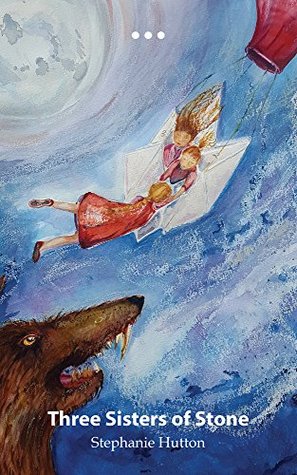
Reviewed by Natalie C. Brown
Stephanie Hutton’s Three Sisters of Stone (Ellipsis Zine, May 2018) is a novella-in-flash that follows three sisters from childhood through adulthood in Australia, spanning about thirty-five years. Hutton is a clinical psychologist living in the UK who rewards her readers with a psychological precision and an economy of language that deepen the reader’s understanding of these characters and their relationships to each other as she moves through slices of their lives. Details are specific and carefully chosen and result in a depth of character and humanity that has stuck with me long after finishing the compact stories.
The novella is told in fifteen flash stories, each designated with the year of their occurrence, from 1981 to 2013, flanked on either side by a prologue and an epilogue. The middle sister, Bella, narrates the stories. Hutton’s decision lends the novella a sense of wholeness it wouldn’t have if each sister had varyingly told part of the story, and provides a sort of symmetry, a narrative choice that makes it feel like looking forward and backward simultaneously.
The prologue begins the novella with a fantastical look at the adult lives of the sisters we don’t yet know. Drawing on the fable of the “Three Little Pigs,” each sister builds a house of a different material—Agnes an “anti-wolf” home of metal without windows, Bella a home of glass bricks from which she can keep vigil for the wolf, and Chloe a door-less, window-less home allowing anyone—any wolf—access. The choice to literalize each personality makes the reader quickly form a distinct idea about each sister, and the references to a wolf establish a sense of danger and foreboding. This opening also provides a blueprint for how the sisters deal very differently with the abuse and neglect visited on them by their parents.
“Fortune Teller” is one of the best examples of this. The sisters make and play with a paper fortune teller, which ingeniously allows for present character development and also shows the sisters imagining future lives away from their abusive childhood. Agnes, the eldest, folds the fortune teller, and Bella writes the fortunes. “There was no point,” Bella says, “in trying to cheat and choose which fortune would be mine, as Chloe would add the colours on the top of each section last.” Agnes gets lost “in the rhythm of moving the paper machine forwards and backwards,” just as she will later get lost in her accounting job, and chooses a fortune that tells her, “You will find your heart’s desire.” Her reaction is subdued as Bella explains that Agnes’s desires are small and obtainable. I get the sense that perhaps her future dreams have already been reduced to the simple need to not be traumatized and abused.
Chloe chooses next and shows her impatience by only having the paper flower move one time. “You will shine bright,” Bella reads to her. Chloe wriggles her fingers in delight and Bella muses about how stars die, and I began to wonder when Chloe will burn out. Bella, having chosen to let both of her sisters go first, ignores her instincts to pick green and instead chooses blue. Agnes reads to her, “Hmm, blue. What will be will be,” and Bella, disappointed with the results, wonders what would have happened had she chosen green like she wanted. In addition to revealing more about the sisters’ personalities, there’s evidence of the punishing psychological effects abuse has on young girls—the sisters’ hopes for the future diminish from youngest to oldest. This is another way Hutton utilizes the middle sister as narrator—Bella is showing us how abuse is cumulative, with Chloe being least affected because she’s been, by virtue of her age, abused for the shortest amount of time.
The abusive father’s presence is felt throughout the girls’ lives, whether psychologically or physically. Details about him become sparse, which works in a surprising way, giving space to the idea that the sisters are unconcerned with what happens to him. Hutton is adept at working in a kind of relief, making certain things clear by their absence and letting the reader’s imagination do just the right amount of work. The tone is dark and it rarely lets up, an ominousness lurking over the sisters wherever they go and whatever happens to them. Hutton seems fascinated with how darkness envelops this family, with Bella wondering after the disappearance of their father, “[W]hat kind of God takes your angry father away but forgets to cure your mother of her sadness?” Hutton is clearly interested in trauma and how it can ricochet through a family, harm being passed around from one member to others.
Another standout, “What Mother Never Did,” is the first glimpse of all three sisters as adults. The effect is like holding a mirror up to their childhood selves. Who we are as adults is so often who we were as children. Chloe is still wild and boy crazy. Agnes is still socially out of touch and overly responsible, her large, shiny car seeming “too big for a woman who usually drove alone, but it had the highest safety rating.” Bella, as always, is sandwiched in the middle, the peacemaker, and it’s no surprise that she weathers the only alone time any of the women spend with their mother. But this gives “What Mother Never Did” one of the most satisfying endings in the book.
In the epilogue, Bella imagines a trip to the mountains with her sisters to visit “the rocks they called the Three Sisters.” Breaking from the past tense of the rest of the stories, it imagines an impossible day, perfect in its distillation of what each of the sisters would do if they could make the trip and ends, predictably, in darkness. Everything in this novella is dense and rendered in miniature, a generation’s life explored in poignant flashes of childhood and character detail that both satisfy and leave the reader wanting more of these girls. As Bella says in the epilogue, “With our view reduced from miles to metres, we’d feel each other’s breaths and heartbeats, the world shrunk down as if there was only us in it.”
__________________________
 Natalie C. Brown is a writer and editor currently pursuing an MFA in fiction at Texas State University in San Marcos. She loves all things bookish and literary and is a lifelong Astros fan. She lives with her (almost) husband and two dogs in Austin, TX. You can follow her on Twitter at @nataliekins.
Natalie C. Brown is a writer and editor currently pursuing an MFA in fiction at Texas State University in San Marcos. She loves all things bookish and literary and is a lifelong Astros fan. She lives with her (almost) husband and two dogs in Austin, TX. You can follow her on Twitter at @nataliekins.

 The core workshop of SmokeLong Fitness is all in writing, so you can take part from anywhere at anytime. We are excited about creating a supportive, consistent and structured environment for flash writers to work on their craft in a community. We are thrilled and proud to say that our workshop participants have won, placed, or been listed in every major flash competition. Community works.
The core workshop of SmokeLong Fitness is all in writing, so you can take part from anywhere at anytime. We are excited about creating a supportive, consistent and structured environment for flash writers to work on their craft in a community. We are thrilled and proud to say that our workshop participants have won, placed, or been listed in every major flash competition. Community works.